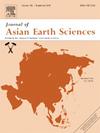The petrogenesis of plagiogranite of the Erenhot Ophiolite in the eastern Central Asian Orogenic Belt: A zircon Hf-O isotopic and whole-rock geochemical perspective
IF 2.7
3区 地球科学
Q2 GEOSCIENCES, MULTIDISCIPLINARY
引用次数: 0
Abstract
Plagiogranite in ophiolite can provide invaluable insights into its origin, magma evolution, and the evolution of oceanic crust. In this study, we conducted a systematic investigation of the zircon U–Pb–Hf–O isotopes, whole-rock geochemistry, and REE modelling of the Early Carboniferous plagiogranites in the Erenhot Ophiolite, the eastern part of the Hegenshan–Erenhot Ophiolite Belt. The newly obtained zircon U–Pb dating results indicate that the Erenhot plagiogranite was formed between 351 Ma and 348 Ma, akin to the Early Carboniferous plagiogranite in Hegenshan Ophiolite. The 348–390 Ma zircons in the plagiogranites are predominantly zircons of an oceanic crust origin, exhibiting radioactive Hf isotopes (εHf(t) of 15.2 to 19.9) and low δ18O values (+2.43 ‰ to +5.00 ‰), indicating that the Hegenshan Ocean likely opened prior to 390 Ma. The Erenhot plagiogranites exhibit low TiO2 (0.09–0.29 wt%), K2O (0.01–0.31 wt%) contents, along with relatively constant La with varying SiO2 contents. Combined with REE modelling, zircon Hf–O isotopes, and ΔFMQ (>0), these features suggest that the plagiogranite originated from the remelting of high-temperature hydrothermally altered gabbro in the younger lower oceanic crust with a highly depleted mantle source, under a relatively oxidizing environment. Significant variations in many major elements and their systematic changes with SiO2, along with diverse Eu and Sr anomalies and REE modelling results, suggest that the parental magma of the plagiogranite underwent two stages of mineral fractional crystallization: first involving clinopyroxene, amphibole, and Ti- magnetite crystallization, followed by plagioclase accumulation and crystallization of amphibole and Ti- magnetite. The enrichment in LREEs, Rb, Ba, Th, and U, depletion in Nb, Ta, and Ti of plagiogranites and gabbros in the ophiolite, and the similar Ordovician–Silurian arc magmatic rocks in the two sides of the Hegenshan–Erenhot Ophiolite Belt, indicate that Hegenshan Ocean likely opened at a pre-existing back-arc basin, with deep mantle upwelling promoting oceanic crust extension.

中亚造山带东部二连浩特蛇绿岩斜长花岗岩成因:锆石Hf-O同位素及全岩地球化学视角
蛇绿岩中的斜长花岗岩可以为其起源、岩浆演化和海洋地壳演化提供宝贵的见解。本文对鹤根山—二连浩特蛇绿岩带东部早石炭世斜长花岗岩进行了锆石U-Pb-Hf-O同位素、全岩地球化学和稀土模拟研究。新获得的锆石U-Pb定年结果表明,二连浩特斜长花岗岩形成于351 ~ 348 Ma之间,与鹤根山蛇绿岩中的早石炭世斜长花岗岩相似。斜长花岗岩中348 ~ 390 Ma的锆石以洋壳锆石为主,其放射性Hf同位素(εHf(t)为15.2 ~ 19.9),δ18O值较低(+2.43‰~ +5.00‰),表明和根山洋可能在390 Ma之前打开。二连霍特斜长花岗岩TiO2 (0.09 ~ 0.29 wt%)、K2O (0.01 ~ 0.31 wt%)含量较低,La含量相对稳定,SiO2含量变化较大。结合稀土模拟、锆石Hf-O同位素和ΔFMQ (>0)等特征,表明斜长花岗岩起源于地幔源高度枯竭的较年轻下洋壳高温热液蚀变辉长岩在相对氧化环境下的重熔。主要元素的显著变化及其随SiO2的系统变化,以及Eu和Sr的不同异常和REE模拟结果表明,斜长花岗岩母岩浆经历了两个矿物分异结晶阶段:首先是斜辉石、角闪洞和钛磁铁矿结晶,其次是斜长石聚集和角闪洞和钛磁铁矿结晶。蛇绿岩中斜长花岗岩和辉长岩的lree、Rb、Ba、Th、U富集,以及蛇绿岩带两侧奥陶系—志留系弧形岩浆岩的Nb、Ta、Ti富集,表明鹤根山洋可能是在弧后盆地形成的,深地幔上升流促进洋壳伸展。
本文章由计算机程序翻译,如有差异,请以英文原文为准。
求助全文
约1分钟内获得全文
求助全文
来源期刊

Journal of Asian Earth Sciences
地学-地球科学综合
CiteScore
5.90
自引率
10.00%
发文量
324
审稿时长
71 days
期刊介绍:
Journal of Asian Earth Sciences has an open access mirror journal Journal of Asian Earth Sciences: X, sharing the same aims and scope, editorial team, submission system and rigorous peer review.
The Journal of Asian Earth Sciences is an international interdisciplinary journal devoted to all aspects of research related to the solid Earth Sciences of Asia. The Journal publishes high quality, peer-reviewed scientific papers on the regional geology, tectonics, geochemistry and geophysics of Asia. It will be devoted primarily to research papers but short communications relating to new developments of broad interest, reviews and book reviews will also be included. Papers must have international appeal and should present work of more than local significance.
The scope includes deep processes of the Asian continent and its adjacent oceans; seismology and earthquakes; orogeny, magmatism, metamorphism and volcanism; growth, deformation and destruction of the Asian crust; crust-mantle interaction; evolution of life (early life, biostratigraphy, biogeography and mass-extinction); fluids, fluxes and reservoirs of mineral and energy resources; surface processes (weathering, erosion, transport and deposition of sediments) and resulting geomorphology; and the response of the Earth to global climate change as viewed within the Asian continent and surrounding oceans.
 求助内容:
求助内容: 应助结果提醒方式:
应助结果提醒方式:


